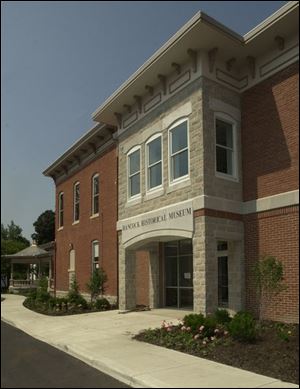
Museum brushes up on its history
6/18/2001
A new entrance to the Hancock Historical Museum is one of the features that were made possible by a $2 million community fund-raising campaign.
FINDLAY - Not long ago, the Hancock Historical Museum's extensive collection of local history items and records was packed into a brick Victorian house on West Sandusky Street and a one-story addition off the back.
The museum's second floor was used only for storage, as was a barn behind the property. Exhibit and educational space was at such a premium that the museum association's board of directors decided in 1998 to undergo an ambitious $2 million fund-raising campaign.
“The board of trustees knew we needed to expand. They knew we'd outgrown our facility,” museum director Sue Tucker said.
Still, for a nonprofit organization that operates on $170,000 a year, the $2 million goal was a high one. “It's pretty amazing that they did this,” Ms. Tucker said.
Now, with all but “a couple thousand” dollars left to raise and some finishing touches to be made, the museum association plans to reopen its home this weekend.
The 1881 Hull House has been completely restored, and a second floor has been added to the large exhibit hall in the rear.
The storage barn, which has been expanded, is an agriculture/transportation building that features two Findlay-built Grant touring cars and one of the world's last Buckeye Steam Traction Ditchers, a Findlay-built machine that was used to dig the trenches for laying tile to drain the Great Black Swamp.
“We just hope this expansion is really well-received. We hope people realize we spent our money like we said we would and worked so hard to make this happen,” Ms. Tucker said.
Tim Brugeman, president of the association's board of trustees, said visitors will be impressed when they see how far the museum has come in 30 years.
“We have taken it from a very small house that had a few things lying around that were of interest to an educational, archival service serving the whole community,” Mr. Brugeman said. “What I'm most excited about is the way we can pass on our heritage to the new generation.
“We have a timeline of history to explain how we came through from the Black Swamp to modern-day industrial parks and foreign-trade zones that are bringing companies from all over the world to Findlay,” he said.
Mr. Brugeman was planting pink geraniums outside the museum's new entrance Friday morning while contractors, volunteers, and inmates from the Hancock County jail continued to work inside the Hull-Flater House, which closed to the public Jan. 1. It has been restored as a house museum, with help from local consultant Marilyn Stroh.
Ms. Stroh said she gleaned information about how the house once looked from whatever sources she could find, including an elderly woman who lived in the house for a time in the 1930s and vividly recalled interior details. “I literally crawled over the building inch by inch, starting from the basement,” Ms. Stroh said. “The house had gone through so many changes.”
Although built as single-family home, it was converted to a duplex at some point and later housed offices before the historical museum association bought it in 1970. It opened as a museum in 1971 though little restoration work was done.
Now, the hardwood floors and elaborate woodwork are gleaming with new finish, windows that had been bricked over are open again, and the front sweeping staircase is open for viewing though it cannot be used by visitors because of its low banister.
The exhibit hall is packed full of memorabilia ranging from Hancock County's role in the Underground Railroad to its once-famous American Mask Manufacturing Co. The second floor includes a Congressional Gallery to recognize the county's six congressmen and a spacious archive and adjacent reading room.
Museum officials hope the expansion will boost interest in Hancock County's history. Ms. Tucker said the museum had an estimated 15,000 visitors in 1999, the last full year it was open, although many of those were school children who came with their classes. “We hope that we will increase visitorship,” said Paulette Weiser, archivist and curator of the museum. “We also hope that we will increase financial support so that we can continue to expand our programming and continue to offer it free. All of us here love history, and we want to get other people enthusiastic about local history, especially the children.”
Third graders from Hancock County come to the museum and its restored one-room schoolhouse on the east side of town for Project School Bell. Fifth graders spend a day at the museum learning about pioneer life in a program called “Hands On History.”
Beyond its focus on children, the museum beginning next month will offer a program tailored to nursing-home residents. Ms. Tucker said groups will visit the museum to take a tour, hear a speaker, and have refreshments. Thanks to the recent renovation, the museum is now handicapped-accessible.
The museum association spent about $1.5 million on the project and placed $500,000 into its endowment fund for operation and maintenance. It received $350,000 in state grants for the construction effort.
A special preview for museum association members and donors to the project will be held Friday night. The museum will be open to the public from 10 a.m. to 4 p.m. Saturday and from noon to 4 p.m. Sunday. A Civil War encampment will be set up all day Saturday on the museum grounds.